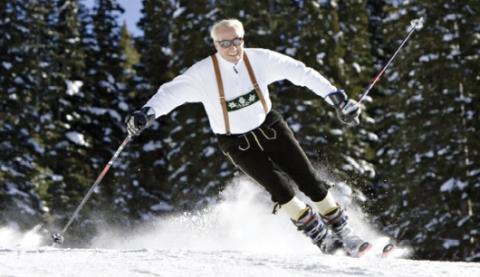
Member Profile: Klaus Obermeyer, who celebrated his 100th birthday on December 2, 2019, embodies skiing’s history in the 20th century. Klaus was raised in Oberstaufen, Bavaria, hard up against the Austrian border and a jumping site since 1908. At age three he nailed his best shoes to a pair of slats from a fruit crate and took himself skiing. From then on, he’s been tinkering to improve ski gear and clothing.
Klaus was seven years old, and skiing on real skis crafted by Marius Eriksen, when Rudolf Lettner patented the segmented steel edge for skis. When he arrived in St. Anton as a teenaged ski instructor, he quickly found a set of Lettner edges and taught himself enough carpentry to install the edges on his own skis. He befriended St. Anton native and Arlberg-Kandahar champion Friedl Pfeifer, who soon departed for America and eventually the 10th Mountain Division.
One of his skiing students offered Klaus an apprenticeship at Maybach, in Friedrichshafen, just 25 miles from home. The company had been founded, in 1909, to build Zeppelin engines. Klaus assembled state-of-the-art engines for trucks, planes and tanks. Then it was to Neuaubing near Munich and a job designing landing gear for Dornier aircraft (not unlike Howard Head’s career drafting parts for the Martin B-26). At night, Klaus attended engineering school for three and a half years.
Klaus rarely talks about this traumatic era. The Dornier factory in Friedrichshafen was heavily bombed, but not the factory in Neuaubing. Klaus says he was desperate to get out of Germany and tried unsuccessfully to ski into Switzerland.
In 1947 Klaus finally made it to America. There he chased down Friedl Pfeifer and began teaching skiing again. That summer he did odd jobs and painted houses. With Warren Miller, he made and sold Bavarian “kugi” ties. But his technical mind saw ways to improve cold-weather comfort for his students. The first problem was terrible leather ski boots. He improved the standard double-boot design with a comfy cushioned rubber innerboot and had it manufactured by Wagner and Rieker (about 40 miles northwest of Friedrichshafen) under his own label Garmisch. It sold for $44.95. With Pfeifer he formulated and sold a high-altitude sunblock cream. Then he imported sweaters and innovative turtlenecks, Carrera goggles and nylon windshirts.
1955 was a breakthrough year. Klaus adapted the down parka (marketed to hunters since 1935 by Eddie Bauer) for skiers, using water- and windproof nylon fabric, and patented the first “flow” material for ski boots (“It was auto grease,” he confided in 1982). In 1967 he set up a production line to manufacture Bob Smith’s double-lens goggle, imported Sanmarco ski boots beginning in 1972, and introduced the first two-prong ski brake, long before major binding companies picked up the idea. Meanwhile, sales of colorful, comfortable skiwear designs by wife Nome grew, becoming the premier American skiwear brand by the early ‘70s.
Klaus still comes to the office daily, still skis, swims and rides his horses. “I really love Skiing History,” he says. “It’s so nice to have a publication that talks about the development of skiing, how it started and grew in America and worldwide. I love to read it, and to see pictures of my old friends!” —Seth Masia
This article is based on several interviews with Klaus, conducted by the author over the years, beginning in 1975.
